The Plextor M6V (256GB) SSD Review
by Billy Tallis on October 12, 2015 8:00 AM ESTMixed Random Read/Write Performance
Most real-world use consists of a mix of reads and writes, and interleaving the two often poses a particular challenge to drive controllers. This mixed random access test is conducted across a 16GB span of the drive, but on a full drive and with a queue depth of 3.
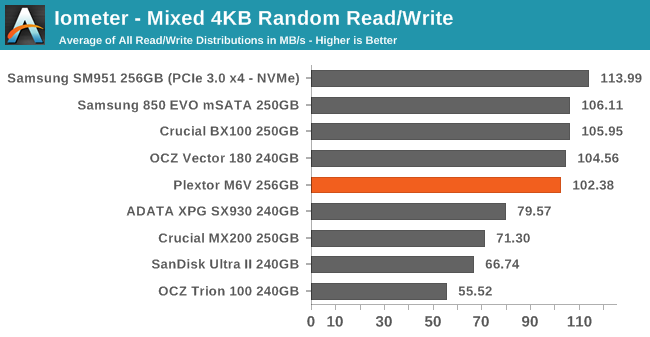
Once again the M6V is in the top performance tier, but is the slowest of that bunch. The SATA interface isn't even close to being a limitation here.
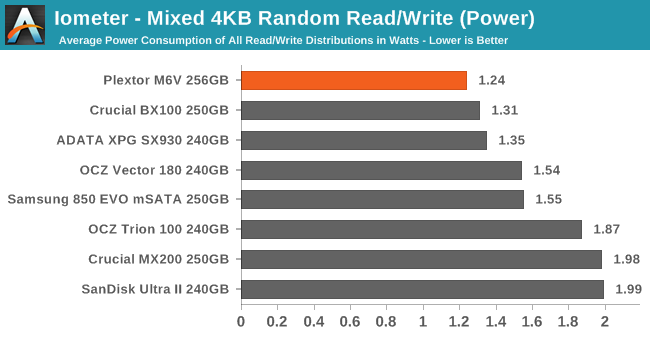
The slight degree to which the M6V lags behind the performance of the BX100 is made up for by the power savings.
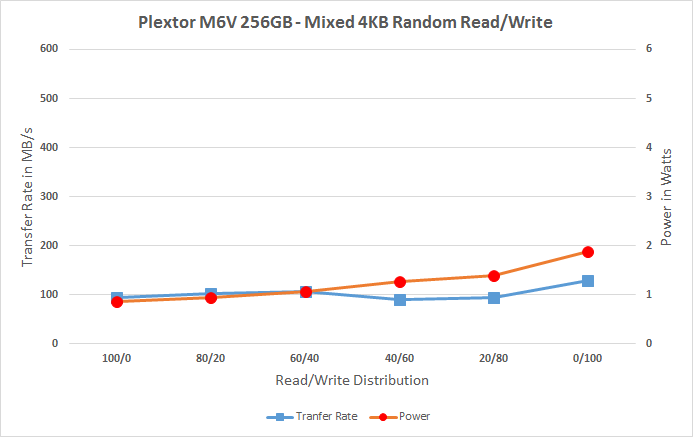 |
|||||||||
| Default | |||||||||
Performance is pretty flat across this test, and the power consumption grows slowly as more writes are thrown in to the mix. The OCZ Vector 180 pulls ahead on the strength of its performance in the 100% write test, while the Crucial BX100 and Samsung 850 EVO are helped by stronger performance in the read-heavy parts of the test.
Mixed Sequential Read/Write Performance
The queue depth of 3 is sufficient for many drives to perform very well at either end of this test, while testing 100% reads or 100% writes. In between, performance typically suffers greatly, and that's where the winners and losers of this test are determined. Anything that's duplicating duplicating or transforming a large amount of data on the drive will produce I/O patterns similar to this test. Creating a System Restore snapshot, backing up files to a different directory on the same drive, and file compression can all produce interleaved reads and writes of large blocks of data, though not necessarily fast enough to be limited by the drive's performance.
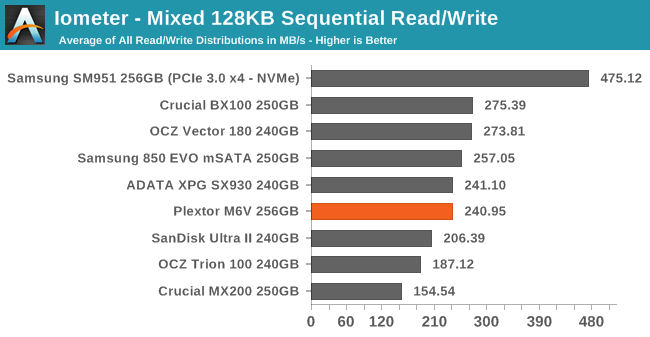
The Crucial BX100 performed very well on this test, but the M6V is only average here.
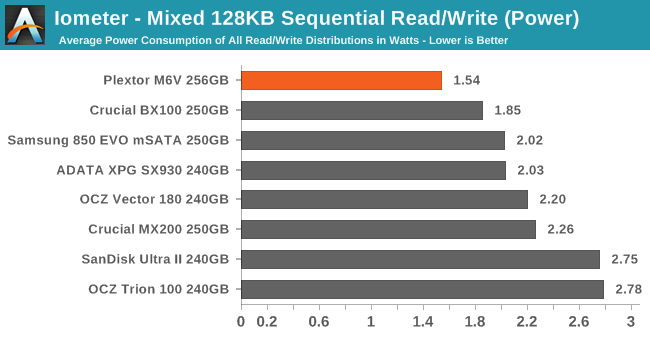
The M6V is once again solidly in the lead for power consumption, and is well ahead of even the BX100.
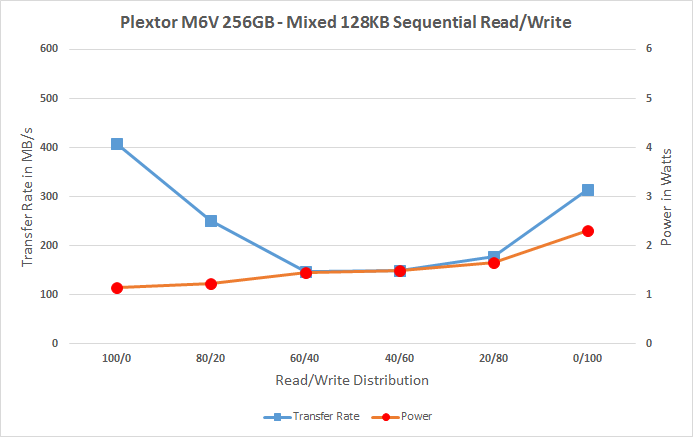 |
|||||||||
| Default | |||||||||
The M6V drops just below 150MB/s during the worst parts of this test, then recovers well as the workload shifts toward pure writes. Its relatively low performance on the 100% read and 100% write portions of the test are keeping the average down.










51 Comments
View All Comments
eddieobscurant - Monday, October 12, 2015 - link
when is the samsung 950 pro review coming up?Billy Tallis - Monday, October 12, 2015 - link
Soon.I wanted to start with a more straightforward and predictable review to make sure I had the test rig set up correctly. The 950 Pro review calls for some deeper investigation than this one, since it's the first real mainstream consumer NVMe drive and there are custom drivers and stuff like that to investigate.
coolhardware - Tuesday, October 13, 2015 - link
Sweet action, looking forward to it! :-)Coup27 - Tuesday, October 13, 2015 - link
Billy when you do the review for the 950 Pro would you be able to do a couple of paragraphs recapping over SATA Express, PCI Express, M.2, U.2 and anything else related to it? I've half kept up to date but I don't think they've done a great job of keeping it clear either.Xichekolas - Wednesday, October 14, 2015 - link
Mind having a section on Linux support/compatibility/etc in the 950 review? When you say "custom drivers and stuff like that to investigate" it makes me dread the buy-new-product-wait-a-month-for-kernel-support routine.Billy Tallis - Wednesday, October 14, 2015 - link
As I understand it, the custom drivers for NVMe is a thing everybody is doing to get around the limitations of Microsoft's driver, like not being able to send administrative commands to the drive (including the equivalent of secure erase). At least some of the features of Samsung's SSD Magician software will probably require their NVMe driver. I have yet to encounter a custom NVMe driver for Linux, only vendor-specific management tools.Anyways, the 950 Pro review's section on compatibility will be as thorough as I have time and resources for. I've done some work to equip our testbed to measure PCIe power consumption for the first time, which means I really should re-test the SM951 and XP941 for comparison's sake.
Cliff34 - Monday, October 12, 2015 - link
Thanks for the review. But it seems like these days if the SSDs cannot differentiate themselves either in price (cheaper the better), speed (faster the better) and reliability (the longer the better), there's very little incentive to buy a SSD that's somewhere in the middle.If you want value, get the BX100 (or one that's on sale) or if you want speed, get the Samsung 850 Pro or the Sandisk Extreme Pro.
zodiacfml - Monday, October 12, 2015 - link
Even Intel/Micron isn't sure if they can compete with Samsung.MagickChicken - Wednesday, October 14, 2015 - link
So am I right in thinking that this generation of consumer-grade SATA SSDs operates roughly 50% better than my current SSD, the Vertex 3?http://www.anandtech.com/show/4256/the-ocz-vertex-...
Seems like there'd be a higher increase in performance over four years considering how new the market was in 2011, though I'm certainly not going to knock the 50-60% drop in $/GB. Or is there a more significant change in the benchmarks that I'm not picking up on?
Billy Tallis - Sunday, October 18, 2015 - link
Some of the benchmark metrics are simply hitting SATA limits on bandwidth and latency. Others are constrained by the limited parallelism of interactive I/O, so the fundamental performance limits of NAND flash are showing through.Also keep in mind that pretty much all NAND production advances have been used to drive down cost, not to improve performance or reliability. We could be making SLC that's cheaper than the MLC used in early SATA SSDs, but the market prefers increased capacity and that's why we have TLC drives now and complicated slow error correction methods to keep them mostly working.